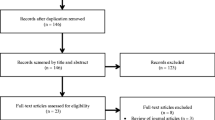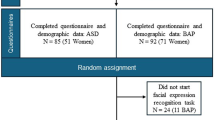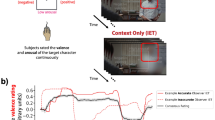Abstract
In recent years, there has been a growing emphasis on Autism Spectrum Disorder (ASD), marked by evolving classifications and increasing global prevalence. Early intervention is underscored as crucial for effective management of ASD, given that emotional dysregulation is a prominent characteristic, leading to challenges in regulating and expressing emotions in a typical manner. This study aims to propose the utilization of Empatica E4 (at the physiological level) and Face tracking (at the behavioral level) as a real-time emotion detection system, exploring its potential impact on interventions based on the Pivotal Response Treatment method (PRT) for children with autism. The goal is to enhance understanding of the child’s emotions, facilitate communication, strengthen emotional connections during interventions, and promote strategies for managing intense emotions.
Integrating a real-time emotion detection system into PRT interventions holds promise for significantly enhancing the therapeutic process. By providing valuable insights into the child’s emotional state, this approach offers a promising avenue to tailor treatments to individual needs and provide greater emotional support and social development for children with ASD.
Access this chapter
Tax calculation will be finalised at checkout
Purchases are for personal use only
Similar content being viewed by others
References
André, T.G., Montero, C.V., Félix, R.E.O., Medina, M.E.G.: Prevalencia del trastorno del espectro autista: una revisión de la literatura. Jóvenes en la ciencia, 7 (2020)
Boateng, E., Otoo, J., Abaye, D.: Basic tenets of classification algorithms k-nearest-neighbor, support vector machine, random forest and neural network: a review. J. Data Anal. Inform. Process. 8, 341–357 (2020)
Boudreau, A.M., Lucyshyn, J.M., Corkum, P., Meko, K., Smith, I.M.: Peer-mediated pivotal response treatment at school for children with autism spectrum disorder. Can. J. Sch. Psychol. 36(1), 34–50 (2021)
Cai, R.Y., Richdale, A.L., Uljarević, M., Dissanayake, C., Samson, A.C.: Emotion regulation in autism spectrum disorder: where we are and where we need to go. Autism Res. 11(7), 962–978 (2018)
Cosoli, G., Poli, A., Scalise, L., Spinsante, S.: Measurement of multimodal physiological signals for stimulation detection by wearable devices. Measurement 184, 109966 (2021)
Drimalla, H., Baskow, I., Behnia, B., Roepke, S., Dziobek, I.: Imitation and recognition of facial emotions in autism: a computer vision approach. Mol. autism 12, 1–15 (2021)
E4 connect. (s. f.). Recuperado 7 de marzo de 2024. https://e4.empatica.com/connect/privacy.php
Flynn, M., et al.: Assessing the effectiveness of automated emotion recognition in adults and children for clinical investigation. Front. Hum. Neurosci. 14, 70 (2020)
Górriz, et al.: Computational approaches to Explainable Artificial Intelligence: advances in theory, applications and trends. Inform. Fusion 100, 101945 (2023)
Grow, L.L., Kodak, T., Clements, A.: An evaluation of instructive feedback to teach play behavior to a child with autism spectrum disorder. Behav. Anal. Pract. 10, 313–317 (2017)
Hazen, E.P., Stornelli, J.L., O’Rourke, J.A., Koesterer, K., McDougle, C.J.: Sensory symptoms in autism spectrum disorders. Harv. Rev. Psychiatry 22(2), 112–124 (2014)
Herrera-Del Aguila, D.: Trastorno del espectro autista: la historia. Diagnóstico 60(3), 131–133 (2021)
Kasari, C., Gulsrud, A., Paparella, T., Hellemann, G., Berry, K.: Randomized comparative efficacy study of parent-mediated interventions for toddlers with autism. J. Consult. Clin. Psychol. 83(3), 554–563 (2015)
Keluskar, J., Reicher, D., Gorecki, A., Mazefsky, C., Crowell, J.A.: Understanding, assessing, and intervening with emotion dysregulation in autism spectrum disorder: a developmental perspective. Child Adolesc. Psychiatr. Clin. 30(2), 335–348 (2021)
Koegel, R.L., Koegel, L.K., Ashbaugh, K., Bradshaw, J.: The Importance of early identification and intervention for children with or at risk for autism spectrum disorders. Int. J. Speech Lang. Pathol. 16(1), 50–56 (2014)
Landowska, A., et al.: Automatic emotion recognition in children with autism: a systematic literature review. Sensors 22(4), 1649 (2022)
Lei, J., Ventola, P.: Pivotal response treatment for autism spectrum disorder: current perspectives. Neuropsychiatr. Dis. Treat. 20, 1613–1626 (2017)
Ojea Rúa, M.: El espectro autista: intervención psicoeducativa. Aljibe, Archidona (Málaga) (2004)
Ona, H.N., Larsen, K., Nordheim, L.V., Brurberg, K.G.: Effects of pivotal response treatment (PRT) for children with autism spectrum disorders (ASD): a systematic review. Rev. J. AutismDev. Disord. 7, 78–90 (2020)
Pérez, M.D.L.L.A., Pérez, R.B.: Alternativas de tratamiento en los trastornos del espectro autista: una revisión bibliográfica entre 2000 y 2016. Revista de psicología clínica con niños y adolescentes 5(1), 22–31 (2018)
Pickles, A., et al.: Parent-mediated social communication therapy for young children with autism (PACT): long-term follow-up of a randomised controlled trial. Lancet 388(10059), 2501–2509 (2016)
Qadeib Alban, A., et al.:. Detection of challenging behaviours of children with autism using wearable sensors during interactions with social robots. In: 2021 30th IEEE International Conference on Robot and Human Interactive Communication (RO-MAN), pp. 852–859 (2021)
Regier, D.A., Kuhl, E.A., El Kupfer, D.J.: DSM-5: cambios en la clasificación y los criterios. Revista Oficial De La Asociación Mundial De Psiquiatría (Wpa) 12, 92–98 (2009)
Rivière, Á.: Autismo: Orientaciones para la intervención educativa. Trotta, Madrid (2001)
Saganowski, S., Komoszyńska, J., Behnke, M., et al.: Emognition dataset: emotion recognition with self-reports, facial expressions, and physiology using wearables. Sci. Data 9, 158 (2022)
Sandhu, M., et al.: Empowering Caregivers of Autism Spectrum Disorder through Sensor-Based Emotional Dysregulation Monitoring. (s. f.)
Schonewille, C.: Sensory processing in autism spectrum disorder (Doctoral dissertation) (2018)
Akansha, S., Surbhi, D.: AutisMitr: emotion recognition assistive tool for autistic children. Open Comput. Sci. 10(1), 259–269 (2020)
Sosa-Piñeiro, K., Rodríguez-Padrón, Y., Romo-Morfa, A.: El Autismo. Evolución de su dimensión teórica/Autism. Theoretical considerations. Educación y sociedad 15, 15–25 (2017)
Stahmer, A.C., Schreibman, L., Cunningham, A.B.: Toward a technology of treatment individualization for young children with autism spectrum disorders. Brain Res. 1380, 229–239 (2011)
Talaat, F.M.: Real-time facial emotion recognition system among children with autism based on deep learning and IoT. Neural Comput. Appl. 35, 12717–12728 (2023)
Toprak, E., Bilgin Aktas, S.N., Coşkun, B., Uluer, P., Kose, H., Barkana, D.E.: Investigation of physiological features by age groups in children with autism. In: 2023 IEEE 36th International Symposium on Computer-Based Medical Systems (CBMS), pp. 287–292. L’Aquila, Italy (2023)
Uljarević, M., Billingham, W., Cooper, M.N., Condron, P., Hardan, A.Y.: Examining effectiveness and predictors of treatment response of pivotal response treatment in autism: an umbrella review and a meta-analysis. Front. Psych. 12, 766150 (2022)
Varghese, D.: Comparative study on classic machine learning algorithms. Accessed 28 July 2021 (2018)
Verschuur, R., Didden, R., Lang, R., Sigafoos, J., Huskens, B.: Pivotal response treatment for children with autism spectrum disorders: a systematic review. Rev. J. Autism Dev. Disord. 1, 34–61 (2014)
Widen, S.C., Russell, J.A.: Young children’s understanding of other’s emotions. Handb. emotions 3, 348–363 (2008)
Zúñiga, A.H., Balmaña, N., Salgado, M.: Los trastornos del espectro autista (TEA). Pediatría integral 21(2), 92–108 (2017)
Acknowledgements
This project has received funding by grant PID2020-115220RB-C22 funded by MCIN/AEI/ 10.13039/501100011033 and, as appropriate, by “ERDF A way of making Europe”, by the “European Union” or by the “European Union NextGenerationEU/PRTR”, and was funded in part by grants DTS19/00175 and PDC2022-133952-100 from the Spanish “Ministerio de Ciencia, Innovación y Universidades” and by the European Union’s Horizon 2020 Research and Innovation Programme under Grant Agreement No. 899287 (NeuraViPeR), as well as the “Premio Tecnologías Accesibles de Indra y Universia Fundación”.
Author information
Authors and Affiliations
Corresponding authors
Editor information
Editors and Affiliations
Rights and permissions
Copyright information
© 2024 The Author(s), under exclusive license to Springer Nature Switzerland AG
About this paper
Cite this paper
Benedicto, G., la Paz, F.d., Fernández-Caballero, A., Fernandez, E. (2024). Real-Time Emotion Detection System’s Impact on Pivotal Response Training Protocol. In: Ferrández Vicente, J.M., Val Calvo, M., Adeli, H. (eds) Artificial Intelligence for Neuroscience and Emotional Systems. IWINAC 2024. Lecture Notes in Computer Science, vol 14674. Springer, Cham. https://doi.org/10.1007/978-3-031-61140-7_34
Download citation
DOI: https://doi.org/10.1007/978-3-031-61140-7_34
Published:
Publisher Name: Springer, Cham
Print ISBN: 978-3-031-61139-1
Online ISBN: 978-3-031-61140-7
eBook Packages: Computer ScienceComputer Science (R0)




